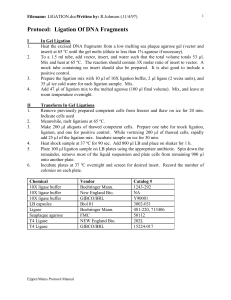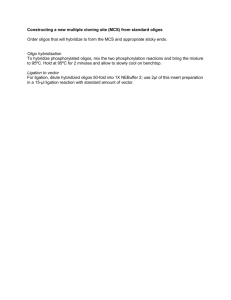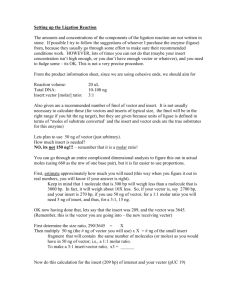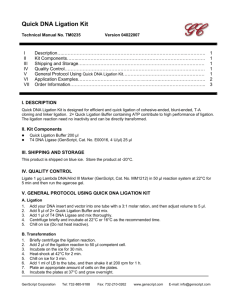LibraryConstruct
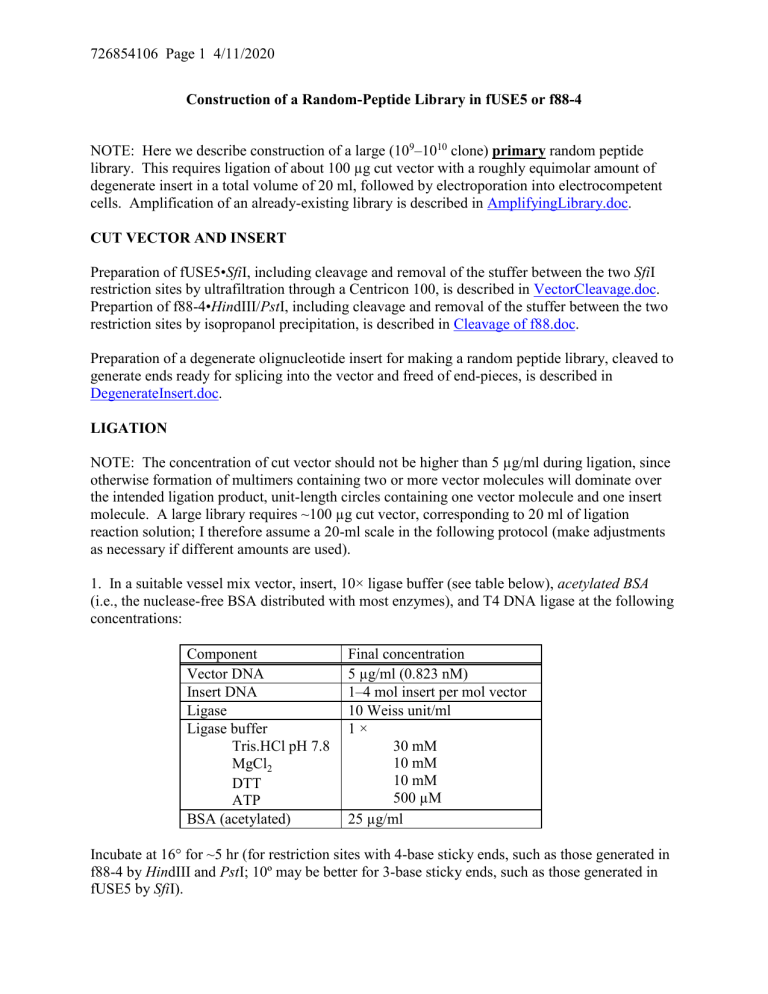
726854106 Page 1 4/11/2020
Construction of a Random-Peptide Library in fUSE5 or f88-4
NOTE: Here we describe construction of a large (10
9 –10 10
clone) primary random peptide library. This requires ligation of about 100 µg cut vector with a roughly equimolar amount of degenerate insert in a total volume of 20 ml, followed by electroporation into electrocompetent cells. Amplification of an already-existing library is described in AmplifyingLibrary.doc
.
CUT VECTOR AND INSERT
Preparation of fUSE5•
Sfi I, including cleavage and removal of the stuffer between the two Sfi I restriction sites by ultrafiltration through a Centricon 100, is described in VectorCleavage.doc
.
Prepartion of f88-4• Hin dIII/ Pst I, including cleavage and removal of the stuffer between the two restriction sites by isopropanol precipitation, is described in Cleavage of f88.doc
.
Preparation of a degenerate olignucleotide insert for making a random peptide library, cleaved to generate ends ready for splicing into the vector and freed of end-pieces, is described in
DegenerateInsert.doc
.
LIGATION
NOTE: The concentration of cut vector should not be higher than 5 µg/ml during ligation, since otherwise formation of multimers containing two or more vector molecules will dominate over the intended ligation product, unit-length circles containing one vector molecule and one insert molecule. A large library requires ~100 µg cut vector, corresponding to 20 ml of ligation reaction solution; I therefore assume a 20-ml scale in the following protocol (make adjustments as necessary if different amounts are used).
1. In a suitable vessel mix vector, insert, 10× ligase buffer (see table below), acetylated BSA
(i.e., the nuclease-free BSA distributed with most enzymes), and T4 DNA ligase at the following concentrations:
Component
Vector DNA
Insert DNA
Final concentration
5 µg/ml (0.823 nM)
1–4 mol insert per mol vector
Ligase
Ligase buffer
Tris.HCl pH 7.8
MgCl
2
DTT
ATP
10 Weiss unit/ml
1 ×
30 mM
10 mM
10 mM
500 µM
25 µg/ml
BSA (acetylated)
Incubate at 16° for ~5 hr (for restriction sites with 4-base sticky ends, such as those generated in f88-4 by Hin dIII and Pst
I; 10º may be better for 3-base sticky ends, such as those generated in fUSE5 by Sfi I).
726854106 Page 2 4/11/2020
5. Run 20 µl (+ 3.3 µl 70/75/BPB ) on a 0.8% agarose/
4 × GBB
minigel containing 1 µg/ml ethidium bromide (add ethidium bromide from a 0.5 mg/ml stock after the gel solution has cooled to <50º) next to suitable DNA markers (such as · Bst EII or
· Hin dIII); include 1 µg/ml ethidium bromide also in the tank buffer. Meanwhile, freeze the bulk of the ligation mix while waiting for the gel electrophoresis results.
NOTE: The intended ligation product is unit-length covalently closed circular (ccc) DNA molecules containing 1 molecule of vector spliced at both ends to one molecule of insert. These ccc molecules are a mixture of ~7 different topoisomers that have very little supercoiling, and that separate under ordinary electrophoresis conditions. Adding ethidium bromide to the gel introduces positive supercoils into the ccc molecules in sufficient density to cause all topoisomers to co-migrate like ~5-Kbp linear double-stranded fragments (this is also where the negatively supercoiled RF molecules that exist naturally in the infected cell migrate). We find that a ligation yielding ~10% of such a band (along with many other bands, representing numerous other ligation products) gives excellent libraries. Often we get good libraries even if no ccc molecules are detectable, provided some open-circular product (co-migrates with ~11-
Kbp linear double-stranded fragments) is apparent. If you are unsure of the quality of the library, it is valuable to do a small-scale elecroporation with a diluted sample representing 0.1 µl (0.5 ng) of the ligation mixture to transfect 50 µl electrocompetent cells as described in steps 18–27 of electroporation.doc
; a good ligation will yield ~10
7
transfectants/µg (5000 transfectants per 0.5 ng).
6. For every ml of frozen ligation mixture add 100 µl 3 M NaOAc (2 ml for a 20-ml ligation) and 50 µl
250-mM EDTA (1 ml for a 20-ml ligation)—a 1.25-fold excess over the Mg
++
present.
Allow the mixture to thaw, mixing in the EDTA; for a 20-ml ligation, the total volume is now 23 ml.
7. Divide the ligation mixture evenly into 30-ml glass Corex tubes, with no more than 7 ml per tube (5.75 ml in each of four tubes for a 20-ml ligation). To each tube add 2 vol absolute ethanol
(11.5 ml ethanol for a tube containing 5.75 ml aqueous solution); cover with parafilm and invert tube to mix. Allow to sit in refrigerator overnight.
8. Centrifuge at 10 Krpm for 20 min at 4º in the Sorvall SS34 rotor (or equivalent), using thinwalled rubber adapters and marking the centrifugal edge of the tubes (in glass tubes, the precipitate makes a thin coat along the centrifugal wall that is difficult to see); RRR ; dry the precipitate briefly under vacuum.
9. Dissolve and pool all three precipitates in a total of 2 ml TE . Load the DNA on a Centricon
100-KDa ultrafilter (Amicon) and concentrate by centrifuging at 2.5 Krpm in the Sorvall SS34 rotor (with thick-walled rubber adapter); wash three times with TE by adding buffer to the 2-ml fill mark and re-centrifuging. Collect the retentate by back-centrifugation as in the Centricon instructions; pipette the retentate into a 500-µl Ep tube. Use a 200-µl pipetter to measure the volume of retentate (usually ~100 µl). To the Centricon, add a volume of TE equal to the difference between the retentate and 180 µl; vortex to thoroughly wash the membrane; collect
726854106 Page 3 4/11/2020 the wash by back-centrifugation as in the Centricon instructions; add the wash to the retentate in the 500-µl Ep tube. The total volume should now be 180 µl.
10. Use twelve 15-µl portions to electroporate twelve 200-µl portions of electrocompetent cells as described in steps 18–26 and 28 of electroporation.doc
. For libraries in f88-4 vector, be sure to add IPTG to 1 mM if necessary to induce the recombinant gene VIII (not necessary in a
MC1061 host cells, which have no lacI gene). You’ll end up with four 1-liter cultures, the virions in the supernatant representing the library.
11. Purify virions from these cultures as described in steps 2–4, 6–7 and 9–20 of
VirionPurification.DOC
, using the modifications that omit detergent treatment.
NOTE: It is not necessary to purify library virions to the high degree achieved in the recommended protocol; doubly-PEG-precipitated virions (steps 2–4, 6–7 and 9–20 of
VirionPurification.DOC
) are adequately pure. However, for a valuable general-purpose library that we intend to use over many years, we proceed with the remaining steps to ensure highly purified virions that should be stable for decades.
12. We usually sequence a sample of the phage as described in sequencing.doc
to confirm the degenerate region of the coding sequence.

